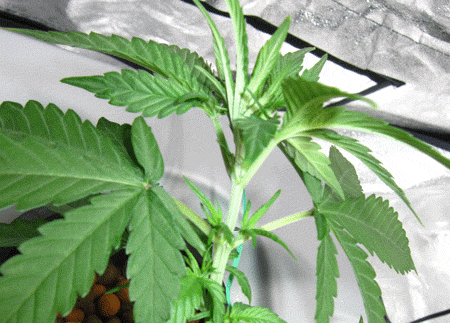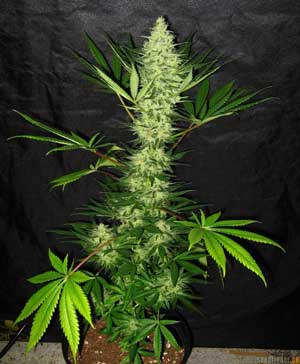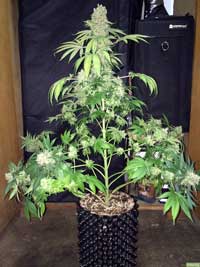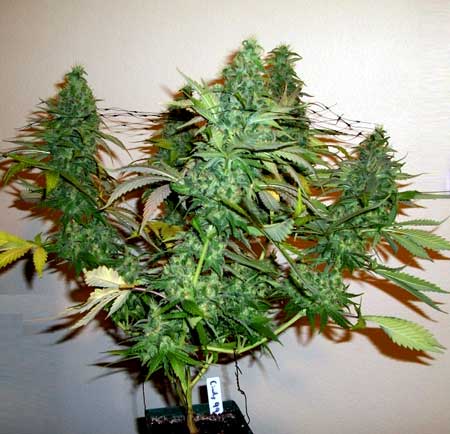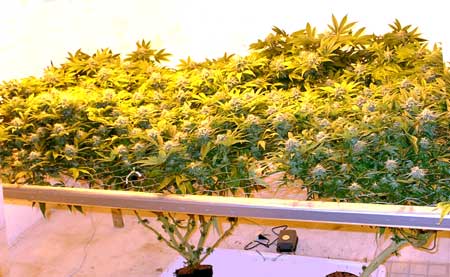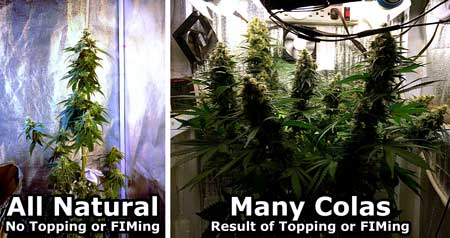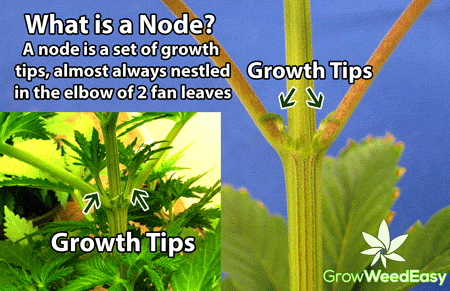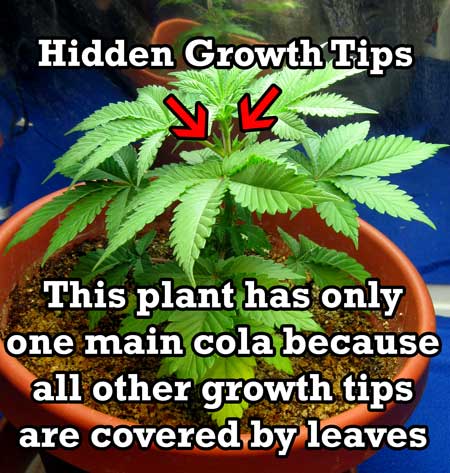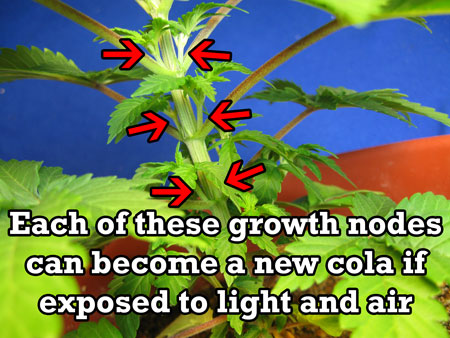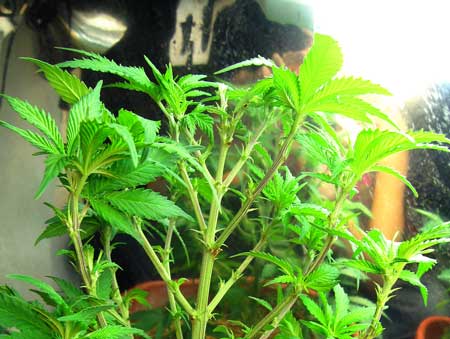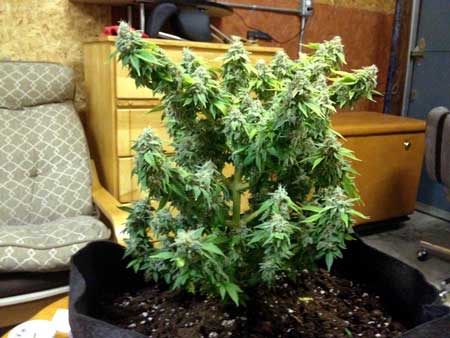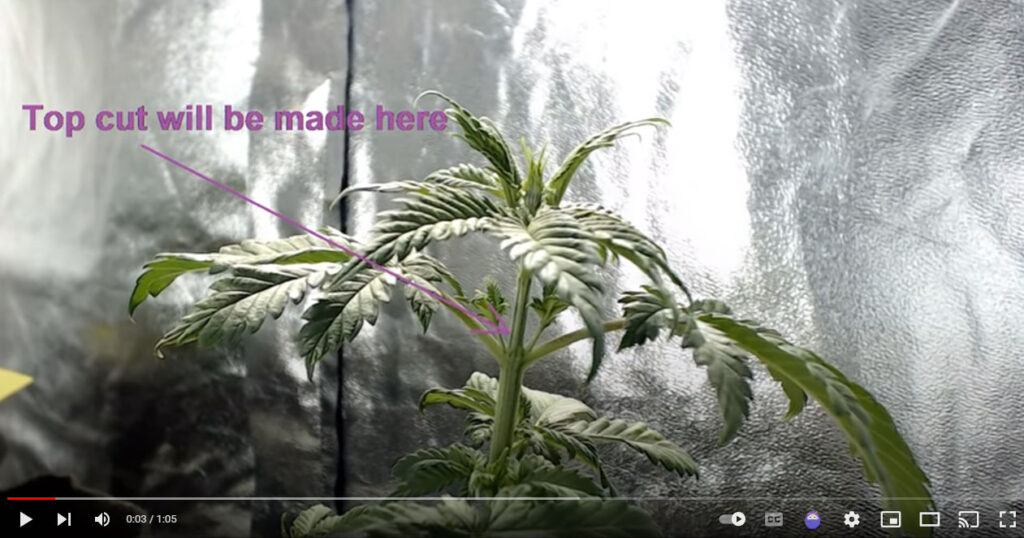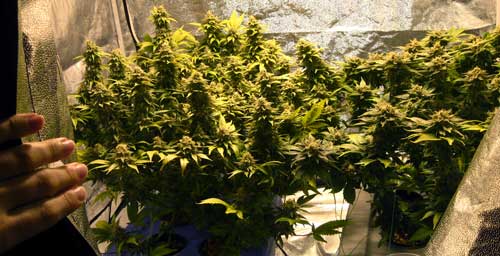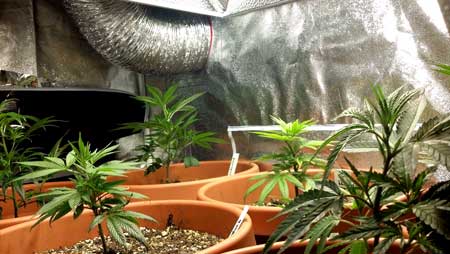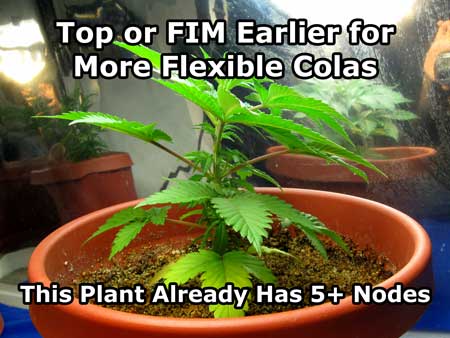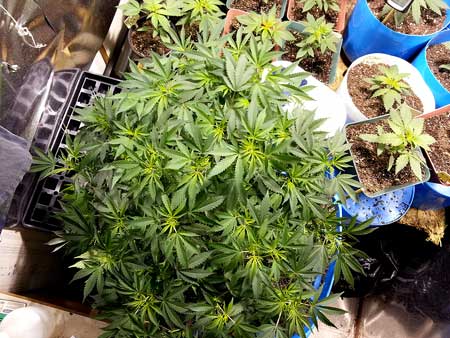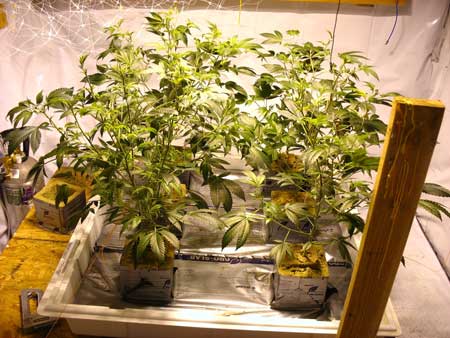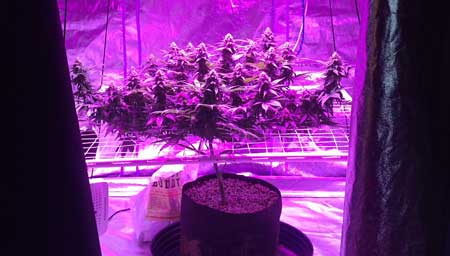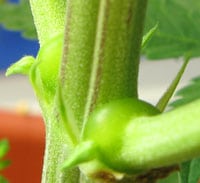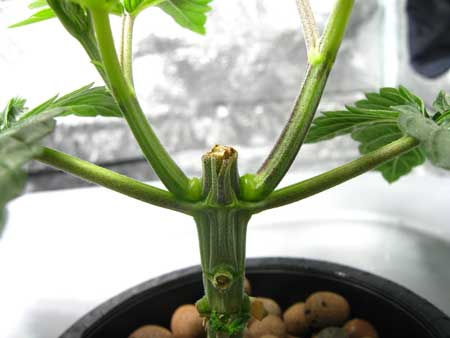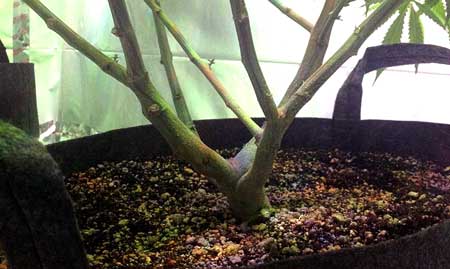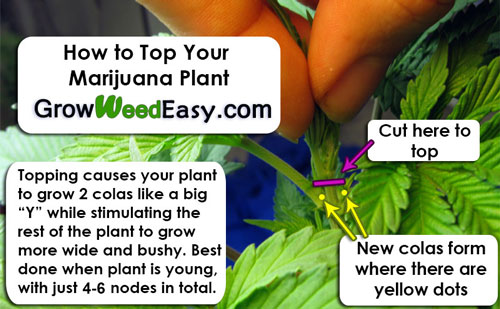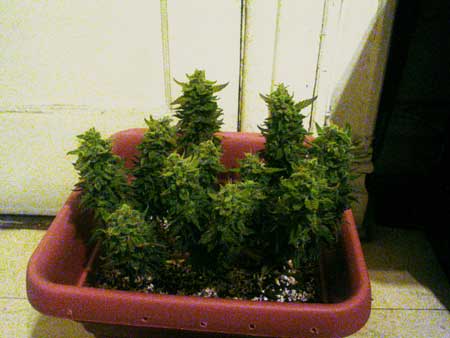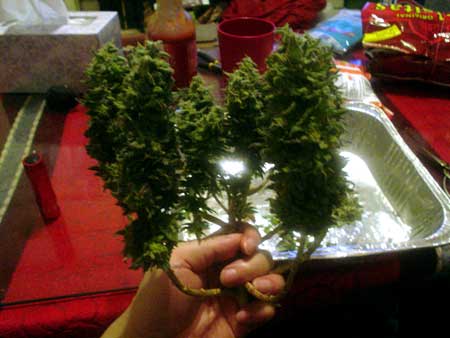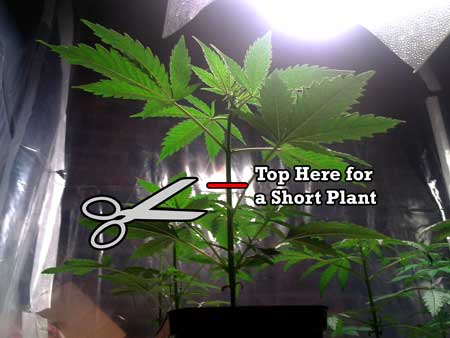by Nebula Haze
Cutting Cannabis For Better Structure: “Topping”
Topping is a cannabis plant training techniques that involves cutting off the top of a main stem. The technique is designed to give you a free way to create more colas as well as spread out the plant so you can take advantage of all your light. As a result, topping can help you achieve bigger marijuana yields!
Most plants naturally only have one main stem. The idea of “topping” is to cut off the top of a main stem to split it into two.
The two growth tips that remain will each develop into their own stem. Each stem can turn into a bud/cola in the flowering stage, so by topping the plant once or a few times, you increase the total number of buds sites under the grow light, and it also helps you keep the plant flat and wide.
It you let a marijuana plant grow naturally, it will usually grow one main stem
But if you top the plant when it’s young, you can cause it to grow multiple colas in basically the same amount of time! This often lets you grow more bud in the same amount of space with the same grow light.
…In the same amount of vertical space as a plant like this
All plant training techniques are designed to help growers get a more desirable plant shape and bigger yields without changing other aspects of their grow. For example, cannabis plants don’t naturally grow in a way that takes full advantage of indoor grow lights – a lot of light is wasted when cannabis plants are allowed to grow naturally without training.
Because of this, cannabis plant training techniques like topping are especially effective at increasing yields in indoor grow setups by creating a bushier plant with extra colas.
Notice how these plants have many colas instead of just one – this is due to using plant training techniques like topping.
These plants show the difference between one main bud (how cannabis naturally grows) and when you top the plant for multiple big buds.
In the above example, the plant on the left was allowed to grow naturally, which resulted in the classic “Christmas tree” shape that’s not very efficient under indoor grow lights. The plant on the right was topped as a seedling. This broke the dominance of the main cola, and the plant started putting out multiple colas.
With topping, the growth tips that become new colas are already present. They just get bigger and become colas because topping breaks the symmetry of the plant and exposes these growth tips to light and air. Instead of focusing on just one cola, the plant starts focusing on many growth tips until they become colas.
Topping Involves Removing or Damaging Top Growth – This Reveals Hidden Growth Tips and Signals Plants to Start Putting Energy Into Them
By damaging the main stem, topping encourages the plant to spend energy growing many colas instead of focusing on just one.
Lower growth nodes will become new colas once they’re exposed to light and air, but they develop much faster when the main cola’s dominance is broken by topping.
Notice how these growth tips have started developing and rising up after the plant is topped (the fan leaves have been removed so you can see the new colas more easily).
Here’s an example of a plant that was topped at a late age, after it had already grown 8 nodes. Although you might not get quite as good results as if you had topped it earlier, it still definitely increased the total number of colas and improved the yields.
Topping Quick Summary
- Cut off the top of the plant at the stem in between nodes
- Creates 2 main colas at the top of the plant, and LST can be used to create more
- New colas are evenly spaced (attached to the stem in the same place)
- Can be used to reduce the height of plants in the vegetative page
- Can slow down growth for a day or two
This video shows the whole cannabis topping process, in timelapse format. The lower growth tips begin to rise up, and each of these can produce even more main colas.
Click here to watch a Youtube video by “fuzzygrow” showing what a cannabis plant looks like after being topped (time-lapse of about 2 weeks).
You will end up with a wider, bushier plant that doesn’t grow just one main cola in a Christmas tree shape.
Some growers will use several phases of topping to produce cannabis plants with dozens of colas. Some techniques take this to the extreme, for example, manifolding (also sometimes called “main-lining”) is a technique that uses topping several times to make a cannabis “manifold.”
Important: Don’t Top Too Early!
With topping, you remove some of the growth on the end of a cola of a young marijuana plant, which causes the plant to stop focusing on one cola (like a Christmas tree) and instead to create many bud-laden colas (grow more bushy).
If you top the plant too early, it will have a hard time recovering. It may seem like a good idea, but you will get the best results and fastest recovery if you wait until the plant has 4-5 nodes.
Wait Until Plant Has At Least 4-5+ Nodes – Topping a Too-Young Seedling Can Slow Down Growth. Waiting a Few More Days to Cut Can Result in a Much Faster Recovery.
Growers use the plant’s natural response to topping to produce short bushy plants with many colas. After the plant has been switched to the flowering stage, the widespread of colas allows the plant to efficiently use indoor grow lights to produce the biggest yields possible.
If you choose to use either of these methods, you will get the best results by doing it when the plant is young, usually when it has around 4-5 total nodes formed.
These young cannabis plants are almost ready to be topped
You get great results by breaking the tendency of the plant to grow one main cola while the plant is still short because you can arrange your multiple colas however you want as the plant develops, instead of dealing with a Christmas tree-shaped plant.
You can also top your plant later in the vegetative stage, but you will have a longer main stalk, giving you less ability to arrange the colas the way you want.
After being topped, your plant will need some time spent recovering in the vegetative stage, though generally this just causes the plant to ‘fill out’ more instead of growing taller, which is often desirable for indoor growers.
This plant was trained for ~2 dozen colas in the vegetative stage
Important: Don’t Top in the Flowering Stage; It’s Too Late!
Topping should only be used in the vegetative stage! In fact, any training technique that involves cutting or damaging your plant should only be done in the vegetative stage of cannabis growth, and never during the flowering/budding stage.
In the flowering stage, only gentle training techniques such as LST or bending should ever be used to change the shape of the plant.
A plant with many colas can only be achieved by training a plant from early in the vegetative stage
Cannabis plants are much less tough in the flowering stage, and they no longer are growing vegetatively (producing new stems or colas).
If you watch a plant in the flowering stage, you’ll see that it doesn’t get taller or develop growth nodes. It only “focuses” on making buds. Topping at this point won’t do any good. Damaging your plant during the budding stage will usually cause a reduction in your final yields.
By the time your cannabis plants are in the flowering stage, much of the growth structure has already been created, and you generally need to try to manage as best you can if your plant has grown into a shape you don’t like.
What if my plant is already too tall in the flowering stage?
If your plant is already too tall in the flowering stage for your grow setup, you’ve got to take immediate action to prevent the plant from getting any taller.
My suggestion is to use bending (LST) to control the height of further growth.
Once flowering is fully underway (after the initial flowering stretch), the plant will not grow much taller, so you can just try to hang on until harvest.
How Can You Tell That Your Plant is Diverting Energy to New Colas?
Almost immediately after topping, the connections to each node become enlarged at the base.
These thickened connections show that the cannabis plant is spreading energy more evenly across the whole plant.
When you see your plant thicken connections like this, it means that the plant is strengthening the “internal system” of the stem, so it’s easier to deliver nutrients and other building blocks. This results in faster growth, bigger colas, and increased yields for each of the affected stems.
The thickening that happens at the base of stems is one sign that the plant is diverting energy to the new colas (where before it was putting the majority of its energy into just the one main cola).
As time goes on, the most used stems can become so thick they’re almost like tree trunks.
How to Top Your Cannabis Plant
When topping your cannabis, you cut off a growing node of the plant, reducing the height instantly. This can be especially beneficial if you’ve let your plant get too tall. Topping also increases the number of colas, which can give you more bud at harvest,
When topping your marijuana plant, it’s best to top the plant when it is young and has 4-5 nodes (sets of leaves) in total. Although you could do it a little earlier, you’re more likely to accidentally stunt your plant the younger it is.
“Topping” the plant means cutting off the newest node on your marijuana plant’s main cola in order to split it into two. However, the word topping can also refer to cutting of the tip of any stem.
A good place to top is directly above the leaves of the next node. In other words, cut through the stem right above its next set of leaves from the top.
This will cause your plant to transfer its energy to two new main colas, as indicated by the two yellow dots in the diagram above.
14-day Timelapse Video of a Cannabis Plant’s Recover After Being Topped
These 2 new colas form a V, which can easily be bent to spread wide. You can top these two new colas a few weeks later and have 4 total colas. This can even be doubled to produce 8 colas that all come from a single “manifold.” Learn more about manifolding cannabis.
Another benefit of topping is how the plant tends to grow bushier afterward, spreading its energy much more evenly around the whole plant.
Often lower branches rise up to become new main colas. This is especially true if you combine Topping with LST to open up the plant so the lower branches get more light.
If you’ve grown a very tall plant, it’s also possible to top your (vegetative) plant down to the node you want to reduce the height but remember that all the time the plant spent getting tall will be lost. In order to get the most flexible colas, without losing vegetative time, try to top early in the plant’s life
If you’re still in the vegetative (non-budding) stage and plants are growing way too tall, you can top the plant immediately to remove height as needed. The time spent growing the extra growth will be lost, so this may add time to the veg stage.
If you want to top the plant multiple times, you may be interested in learning about cannabis main-lining (creating a manifold – a fun and popular cannabis plant training technique).
Jump to…

